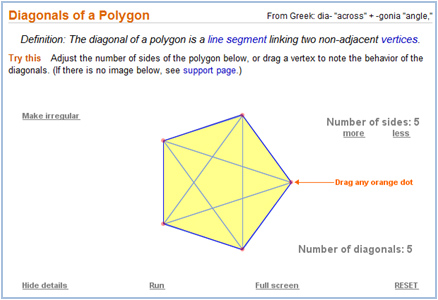

In this lesson, you will use a dynamic geometry sketch to generate multiple figures, and then make conjectures about the resulting patterns.

![]() Open the link Diagonals of a Polygon. The link will open in a new browser window or tab.
Open the link Diagonals of a Polygon. The link will open in a new browser window or tab.
In this sketch, you can change the figure by clicking and dragging any vertex with an orange dot. The sketch will automatically count the total number of distinct diagonals in the polygon.
Use the sketch to complete the data in the table. Before recording the sum of the interior angles, be sure to generate at least four different polygons with that number of sides.
Make a table like the one shown below in your notes.
To check your answers, click on each blank.
| Number of Vertices | 4 | 5 | 6 | 8 | 10 |
| Number of Diagonals from One Vertex | Interactive button. Assistance may be required. _____ 1 | Interactive button. Assistance may be required. _____ 2 | Interactive button. Assistance may be required. _____ 3 | Interactive button. Assistance may be required. _____ 5 | Interactive button. Assistance may be required. _____ 6 |
If any part of a diagonal of a polygon contains points in the exterior of the polygon, then the polygon is considered to be a concave polygon.
If all points on the diagonals of a polygon are contained within the interior of the polygon, the polygon is a convex polygon.

Use the information in the tables to sort the following conjectures into two categories: true conjectures and untrue conjectures.
![]() Drag and drop each conjecture into the correct box. Click the Submit button to see if you have sorted correctly.
Drag and drop each conjecture into the correct box. Click the Submit button to see if you have sorted correctly.
For each untrue conjecture, explain why the conjecture is not true.
Interactive popup. Assistance may be required.A nonagon (9 sides) will have 9 diagonals from any one vertex.
This is untrue because the number of diagonals from one vertex is 3 fewer than the total number of vertices in the polygon. 9 – 3 = 6, not 9.
The number of diagonals from one vertex is the same for a convex hexagon as it is for a concave pentagon.
This is untrue because a convex hexagon has 3 diagonals from one vertex, and a concave pentagon has 2 diagonals from one vertex. Whether or not the polygon is concave or convex does not influence the number of diagonals from one vertex.
